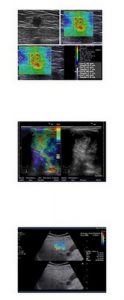Elastography is a simple, quick, non-invasive method with a high level of successElastography is based on the principle that a benign tissue has increased elasticity compared to a malignant one. This new method makes it easier to distinguish between benign and malignant lesions, resulting in a better understanding of the reliable and accurate diagnosis. overrides.
In which cases elastography is recommended:
 MASTOS (Control of forms)
MASTOS (Control of forms)
To distinguish benign from malignant focal lesions resulting in a reduction in the number of biopsies and better planning of follow-up of these lesions.
THYROID GLAND (Nodule control)
In the presence of new nodules or differentiation of the image of older nodules, checking the elasticity of these nodules helps a more accurate assessment and avoids misdiagnosis.
USP (Checking the texture of the liver parenchyma)
It quantitatively assesses the degree of hepatic elasticity. In recent years spate presents another "modern" liver disease ornot alcoholic fatty liver disease, which is directly related to the lifestyle of modern man.In addition to chronic liver diseases, elastography can assess the extent to which fatty infiltration has affected the elasticity of the liver, as well as monitor the effectiveness of treatment.
Ask your doctor today and find out about the benefits of

